|
| Author |
Message |
Grizzlyman
Member
|
# Posted: 3 Jan 2025 03:52pm - Edited by: Grizzlyman
Reply
Anyone know anything about frost heave?
Here’s the situation.
We went and checked on the place last weekend.
I’m not sure when it started but one of my piers has an ever so slight lean. I believe it is because the poured footing is rotating slightly. The top of the footing is not level any longer and I’m fairly certain that it was more or less level when I poured it 5 years ago. It’s causing the pier to be out of plumb by maybe an inch- so it’s just a small movement.
Now. Let me say this.
The diagram below is what a cross section of my site looks like. It’s only a few inches of soil and then bedrock. 11 of my 12 footing are 100% on bedrock.
As you can see on the diagram the soil piles up thicker on the edge before the bedrock runs downhill. It’s probably 3” of soil at my back pier and 2’ at the front pier.
The footing that is causing the lean is in this spot in the thickest soil.
It was poured on top of rock … but MAYBE i was mistaken and it wasn’t bedrock. Maybe it was just some big but loose rock on top of the bedrock. Even if it wasn’t on the bedrock, it’s not far off as the soil isn’t more than 2’ in this spot and I’m down probably 1 1/2 at least.
It doesn’t appear to be heaving, just rotating.
I did pound rebar down between some fractures in the bedrock so it is pinned in place… maybe that’s why it is rotating instead of heaving?
1. Do you think this is frost heave? I do but really don’t know.
2. IF a footing were on bedrock BUT BELOW the ground a foot or two and still surrounded by soil… would it still frost heave? In other words is frost heave due to expansion underneath the footing or can it be affected by soil that is adjacent to it?
3. If it is only from underneath (as I suspect) then that would mean the footing is probably not resting on the bedrock and I probably have to fix come spring time.
Cabin is unaffected and still level. In Fact this 4th pier is for my screened- in porch corner so that is not necessarily structural for the cabin. Most of the weight is on the other 3 piers.
To fix I would probably crib the corner, pull the pier and redo the footing digging down farther or I would dig adjacent to the footing down farther if I can and repour a bigger footing that is down all the way.
Thoughts?
|
|
Grizzlyman
Member
|
# Posted: 3 Jan 2025 04:24pm
Reply
This is actually a great video and probably the issue.
https://youtu.be/9jzycX380PA?si=sZUJmLsl32iFjVOu
|
|
rpe
Member
|
# Posted: 3 Jan 2025 05:02pm - Edited by: rpe
Reply
Here's some more good info:
https://www.slideserve.com/dudley/foundations-with-frost-heave
Frost Heave Protection of Cottage Footings
Here's another good one I can't find a link to. Will try to attach:
|
|
rpe
Member
|
# Posted: 3 Jan 2025 07:04pm
Reply
1.) Sounds like movement due to frost action in the soil to me.
2.) Variations in soil type, moisture content, and local temperature could all result in asymmetrical loading of the pier, causing it to move laterally or vertically.
3.) Even if sitting on bedrock, if the uplift forces are adequate, maybe it's pulling the rebar out from the cracks?
I would crib safely, then excavate, remove the pier, and start over. It doesn't sound like you're down very deep, so it should be a pretty straightforward job.
What kind of soil is present? How is the drainage around the structure? Water table? These will all impact the effectiveness of your solution.
Old-timers on my lake have tried everything over the years - french drains & sump pumps to lower water table, 4x8 sheets of insulating foam buried a few inches below grade to limit frost penetration, excavation of silty/clay soil and replacement with coarse sand/gravel.
|
|
toyota_mdt_tech
Member
|
# Posted: 4 Jan 2025 09:47am - Edited by: toyota_mdt_tech
Reply
Did you use a sono tube or just pour concrete down a hole? I have found concrete in a hole with irregular sides and freezing allows the frozen soil to grab and push up. Also if you put a cap or flare at the top of the hole, same deal. I dig down, install sonotubes smaller than the hole, fill with concrete, leave tube on, then fill gap around tube. Push some dirt in the outside of the sonotube to keep concrete from coming up on the outside of the tube. This also leave the bottom with a nail head or wider then the hole to hold it down. At the bottom of the hole its always nice to fill bottom with nice draining rock too. Once all set, pack dirt or gravel mix. Should be golden
|
|
Grizzlyman
Member
|
# Posted: 5 Jan 2025 09:37am - Edited by: Grizzlyman
Reply
rpe
It all Canadian Shield. Soil type not sure- mostly just rock with soil on top. . Whatever soil there is littered with rocks and roots throughout as roots only have a few inches and everything spreads laterally. No clay or anything. no water table as it’s rock underneath and it’s dry as it’s under the cabin.
toyota_mdt_tech
No sonotube. I built square 24”or so (I forget exactly) forms. I dug down to what I thought was bedrock in this spot. Cleaned off rock well and set forms on rock and the filled. Probably some spill out at bottom. I did this on purpose so the concrete would flow around,adhere to and grab any irregularities in the underlying rock to anchor in place. once dried Removed forms and backfilled. footings are probably not real smooth on edge nor do they have a shape that would discourage frost heave. I imagine just being square vs circular give the soil purchase as well for heaving. I would guess it’s probably as the video describes and it’s grabbing the irregular edges.
Also As mentioned this particular footing might possibly not be on bedrock but just a large rock which is probably sitting on bedrock. And maybe that rock is heaving slightly too?
|
|
Grizzlyman
Member
|
# Posted: 5 Jan 2025 10:10am
Reply
A few pics of the footings that I could find. Two pics of other footings just showing how they were done. The last is of the footing in question completed. unfortunately I don’t have any record/photos of that particular footing before pouring but I remember it. It’s not as deep as I remember though.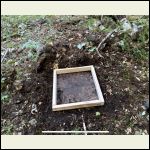
IMG_7521.jpeg
| 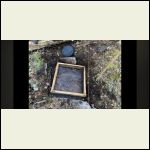
IMG_7524.png
| 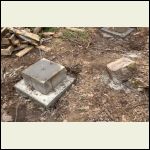
IMG_7526.jpeg
|  |
|
|
rpe
Member
|
# Posted: 5 Jan 2025 10:23am - Edited by: rpe
Reply
Wow, if you're actually on flat bedrock like those first pics, it should be 'rock solid'! Maybe like you said, that bedrock is actually a loose piece, with wet soil underneath?
I've got piers that are 12+ blocks in height, with 8 below grade, pinned to bedrock below the water table. Need to pump out the hole continuously while digging. It does make the rock drilling easy when the water flush happens naturally though!
|
|
|
Brettny
Member
|
# Posted: 5 Jan 2025 07:28pm - Edited by: Brettny
Reply
Did you drill into the rock and epoxy rebar in to cement the footing onto? That really looks less than a few inches underground to me. Concrete anchor epoxy is prety cheap, about $20 a cawlk tube.
It is possible for water to run along bed rock and move everything above it, even a concrete pier that isnt anchored to it. Some of the worst frost heave I have on my property is the dirt directly above bed rock. The dirt moves some 3-4in when it's really frozen.
|
|
Grizzlyman
Member
|
# Posted: 8 Jan 2025 10:57am
Reply
Brettny
Yes drilled in those perfectly flat spots shown in picture as there was no other purchase to be had. Other spots have small cracks in rock that I pounded 4’ rebar into- like the footing in question.
Quoting: Brettny That really looks less than a few inches underground to me.
If you’re saying it looks like it’s barely underground- that’s partially true. There is no “level ground” here as you can see in the pictures. So hard to say where the ground starts… nothing is flat. nothing! The actual footing in question(the completed poured footing in the picture) goes down deeper into the earth. the picture shows areas where it was dug in and you can see in the sides and back that the ground is at least 6” above the lower square footing. . In the front of the footing though-it is above the surrounding ground.
Im guessing it’s probably the dirt on the sides of the underground part that’s in contact with the sides and is moving it slightly.
Quoting: Brettny The dirt moves some 3-4in when it's really frozen.
I guess good news is that it’s not going to thaw and theoretically move again until April at least. We’ll see where we are at then.
|
|
Grizzlyman
Member
|
# Posted: 19 Feb 2025 09:07am - Edited by: Grizzlyman
Reply
Was up snowmobiling at the cabin the previous weekend. (I didn’t feel like chancing the -25 this last weekend  ) )
Took a few photos of the pier.
Here is one. Like anything photos can be tricky with angles. I tried to take it as straight on as possible but I’m sure there’s some perspective here.
I rotated the photo slightly using the iPhones rotate feature and aligned the top beam parallel with the right angles on the crop “square” so that the top beam is perfect parallel.
You can see the pier is off a few degrees from plumb (2* to be exact). You can see the block runs down to the right of the screen slightly as well. That is downhill.
It’s not quite that bad but it concerns me that it appears it’s starting to move.
What I don’t know is if it was always this way or if it has moved. I couldn’t find any other good pictures of years past to compare.
It’s possible it wasn’t perfect when I built it (given the conditions of my worksite.) In any event the beam is level still so I may just support any slight gaps with a shim or two for now until it moves more.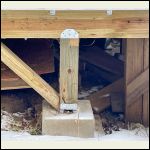
IMG_7822.jpeg
| 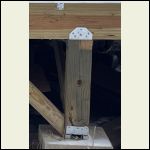
IMG_7823.jpeg
|  |  |
|
|
Brettny
Member
|
# Posted: 19 Feb 2025 10:10am
Reply
That type of post base has no lateral support except for your bracing. Have you thought about just replacing it with a few blocks and shims?
I suspect the support shown was added after?
|
|
Grizzlyman
Member
|
# Posted: 19 Feb 2025 11:24am
Reply
Brettny
I thought this thread was about frost heaving and a moving foundation block?
Here’s a photo of the build that does a good showing the piers and beams working together. This beam is not sliding longitudinally forward anytime in our lifetimes.
It’s the footing…
|
|
FishHog
Member
|
# Posted: 19 Feb 2025 04:49pm
Reply
Personally, I wouldn't worry about it too much yet. Keep and eye on it. Measure now, again in the spring/summer and again next winter.
That is minor movement, if that is it, and it stays there. If it keeps moving, deal with it then.
Its only one post with decent access. Won't be that hard to temp brace it and replace. Breaking out the existing concrete if it keeps moving would be the hardest part.
|
|
gcrank1
Member
|
# Posted: 19 Feb 2025 05:04pm
Reply
Maybe it has settled in and gone as far as it is going to.
I agree, just keep yer eye on it (maybe take a few measurements to use as reference points to make it easy to monitor)
|
|
Grizzlyman
Member
|
# Posted: 12 May 2025 01:04pm - Edited by: Grizzlyman
Reply
I put a level on it this weekend.not sure if it moved this spring at all or not. I’d imagine no. Definitely out of level. Interestingly it is still fairly level across the axis of rotation. Just seems to have rotated.
However the pier itself doesn’t look any more out of plumb so I guess I’ll just keep my eye on it. Idk…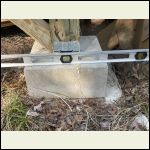
IMG_8766.jpeg
| 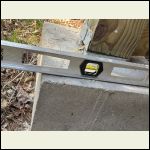
IMG_8767.jpeg
|  |  |
|
|
|

